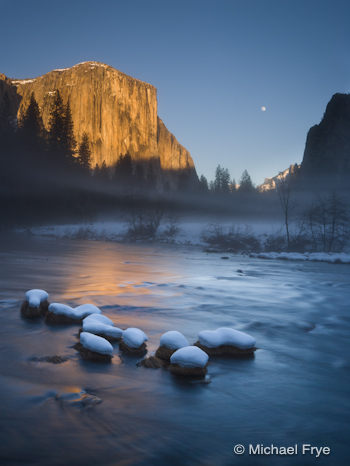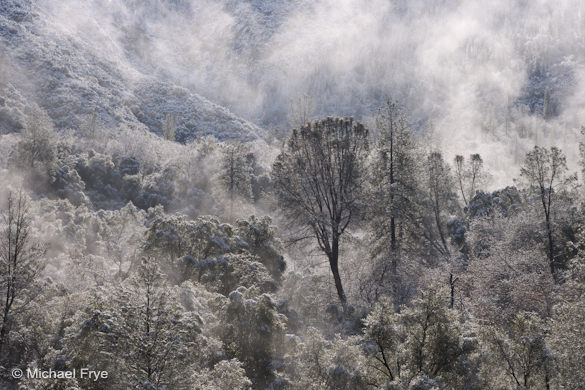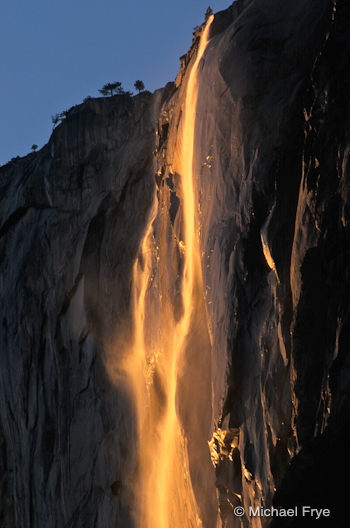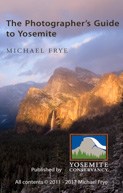by Michael Frye | Jan 19, 2011 | Yosemite Photo Conditions

The moon rising between El Capitan and Cathedral Rocks from Valley View
Clear skies have allowed my workshop students and me to photograph the rising moon on three successive days: over Half Dome on Sunday, between El Capitan and Cathedral Rocks on Monday, and between Half Dome and El Capitan from Tunnel View yesterday. Naturally the timing for this workshop (Photoshop and Digital Printing, with The Ansel Adams Gallery) was planned to take advantage of these lunar opportunities, but you never know what kind of weather you’ll get, so we’ve been lucky.
Where November and December were exceptionally wet, January has been dry so far. Yosemite photographers often hope for precipitation and the opportunity to photograph a clearing storm, but every set of conditions creates unique opportunities. The clear, warm weather is melting the abundant snow pack and producing an exceptionally high flow in Yosemite Falls. It looks more like March than January. The light, however, is still at its winter angles, striking the falls shortly after sunrise—much better than in March, when the sun doesn’t reach the waterfall until it’s high in the sky.
With more clear, warm weather in the forecast, the water flow should stay high or even increase, and we could have great opportunities to photograph Yosemite Falls for several weeks.
If you had a chance to photograph the rising moon the last few days, or the high water in Yosemite Falls this winter, I’d love to see the images, so please post a link in the comments.
by Michael Frye | Jan 14, 2011 | Critiques

“Ptarmigan Lake” by Chris Alexander
Composition
This week’s photograph was made by Chris Alexander in Glacier National Park, Montana. That’s the second time recently that I’ve critiqued a photo from this park. Obviously—and no surprise to anyone who’s been there—a beautiful place!
This composition works very well. The bottom two-thirds of the photograph has sweeping, repeating, U-shaped curves that help tie everything together and frame the background peaks. The lake and mountains provide focal points: my eyes work in a triangle around the frame, going from the lake to the prominent peak on the right, over to the peaks on the left, then back to the lake, sometimes detouring around the lower basin to look at the snow patches and trail. The overall design is simple and strong.
If I could quibble with something, it would be the bright spots along the edges that tend to draw my eyes out of the frame, including the snow patch in the lower-left corner, another snow patch near the upper-right corner, and of course the sky.
(more…)
by Michael Frye | Jan 12, 2011 | Announcements

5. Gray pines after a snowstorm
Jim Goldstein posted his Best Photos of 2010 Blog Project today, with the top images of 2010 from 162 photographers, including me of course. It’s worth spending some time looking through these photographs, as there’s a lot of great work.
For me, picking out my best photos from last year was a difficult, fascinating, but ultimately rewarding process.
(more…)
by Michael Frye | Jan 11, 2011 | Yosemite Photo Conditions

If you’re hoping to photograph Horsetail Fall this February, here’s a post from last year that outlines some of the basics about the timing and best locations. You’ll also find an article on my web site with a detailed description of the factors that go into determining the best dates to photograph this phenomenon.
Since every astronomy program seems to disagree with every other one, it’s hard to figure out exactly what the best dates are each year, but it appears that the window of best light will be a little later this February, from about the 12th to 22nd. Good luck!
by Michael Frye | Jan 6, 2011 | Announcements
I’ll be posting my ten best photographs from 2010 tomorrow, but there’s still time to make your voice heard and help me make the selection. View the top 46 here, then just add a comment and list your favorites.
Many thanks to everyone who’s already chimed in. The response has been tremendous, and almost 100 people have voted. I really appreciate all of you taking the time to do this—you’re the best! And special thanks to those who went to the trouble of giving detailed explanations about their choices—that’s very helpful.












